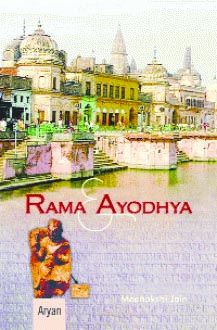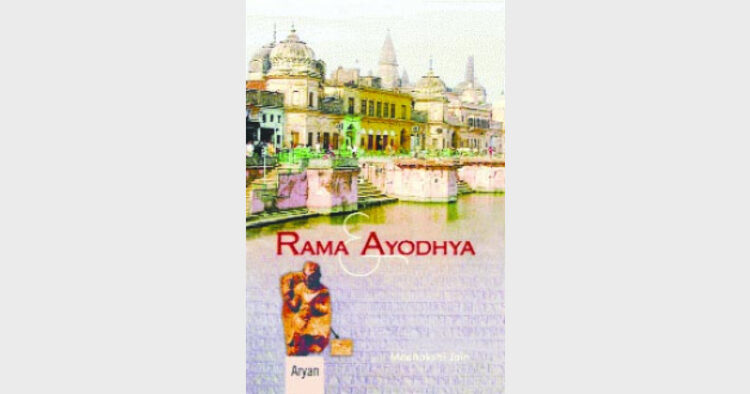Swadesh Singh
 The Indian academic scenario is so gripped by leftist ideology that the people associated with it are unable to think beyond the assumed canons. Other points of view are not entertained and anything that doesn’t fit their 150-year-old Marxist framework can’t be either objective or true. Conversely, they are ready to dole out a hundred fabrications to prove what they think ‘should’ be right. In India, leftist ideology and politics have reached a stalemate. Even the senior leaders and ideologues are at a loss when class-struggle transforms into caste-struggle and when lal salam echoes like wale-qum-asslam. The ideological entanglements have not just harmed their own politics but also the progressive politics of India. Ram Janm Bhumi Movement is no exception as there have been unassailed attempts to obfuscate the issue at various levels and in different ways. The book ‘Rama and Ayodhya’ written by Meenakshi Jain is a brave effort to expose the nefarious designs of such leftist academics.
The Indian academic scenario is so gripped by leftist ideology that the people associated with it are unable to think beyond the assumed canons. Other points of view are not entertained and anything that doesn’t fit their 150-year-old Marxist framework can’t be either objective or true. Conversely, they are ready to dole out a hundred fabrications to prove what they think ‘should’ be right. In India, leftist ideology and politics have reached a stalemate. Even the senior leaders and ideologues are at a loss when class-struggle transforms into caste-struggle and when lal salam echoes like wale-qum-asslam. The ideological entanglements have not just harmed their own politics but also the progressive politics of India. Ram Janm Bhumi Movement is no exception as there have been unassailed attempts to obfuscate the issue at various levels and in different ways. The book ‘Rama and Ayodhya’ written by Meenakshi Jain is a brave effort to expose the nefarious designs of such leftist academics.
Meenakshi Jain teaches History in Delhi University and has from time to time raised several issues that have been sidelined in the academic discourse driven by JNU-type historians. Why this bunch of leftist historians is so selective in their ideation, research and analysis is subject matter for a separate article.
Lucknow Bench of Allahabad High Court pronounced in its verdict on September 30, 2010 that the disputed site is nothing but the temple of Ram Lala and sacred place for crores of Hindus and therefore, should be granted to the Hindus. The High Court’s decision was based on a report submitted by the ASI’s excavation team constituted by the order of the court. During the excavation at the disputed site, the ASI found the remains were of a temple that was destroyed and over which a mosque was constructed.
The writer of this book has brilliantly chronicled the early history of Ayodhya and Ramayana which provides substantial evidences of the existence of a temple of Lord Ram in Ayodhya. While it records the puranic and literary evidences on one hand, it also compiles evidences, facts and courts proceedings on the other, to counter the arguments of the historians who pitch for legitimacy for the disputed structure.
The author makes a long journey of research and study in her quest of Ram, Ramayana and Ayodhya. Working right through folklore to historic evidences Jain gives us a great tome of academic research. Her book also challenges the leftist historians whose selective footnotes and referencing negate the existence of Ram and declares that the issue of Ayodhya as birthplace of Ram is merely 200 years old created by some British writers. She also mentions how in 1989, 25 historians of JNU initiated the academic debate on Ramjanm Bhumi by publishing a book and laying the foundation of an ideological fraud. Even after the Court’s verdict, they did not stop and as a part of their campaign they organised several seminars and published many booklets denouncing the verdict.
Jain’s lucid style of handling such a complicate subject, makes it a gripping read. Also, given the span and scope of the subject covered it deserves a place on the shelf of those who value quality research.
The introductory chapter makes it clear that there is ample proof that disputed structure was made after demolishing a temple which was worshiped as the birthplace of Lord Ram. In the second, third and fourth chapters the writer takes the help of the literary, sculptural and epigraphic evidences to prove the antiquity and popularity of Ram among common masses. While the introductory chapter makes a strong pitch for Ramjanm Bhumi in Ayodhya, the last one argues that there is no case for mosque. The writer gives evidences from revenue and waqf records of the pre-independence era and judicial pronouncements in earlier cases involving Hindu deities which undermine the Babri case.
Shedding new light on the subject, the writer says that the struggle for Ramjanm Bhumi is hundreds of years old and that the Vishwa Hindu Parishad just carried forward the ancient legacy through the Ram Janmbhumi movement of 1980-90s. Jain gives an account of the historic struggles for the holy site.
This book unmasks the Leftist writers and historians who have, on one hand, tried to project Hindu faith as hogwash and on the other, have joined efforts to falsify the existence of Ram. It is indeed shocking to know that many of these historians gave statements in court which were later found to be false.
Jain quotes Gandhiji, “The general spirit of India was most vividly reflected in the Ramayana”. It is a great misfortune of the nation that on this land we have to prove the existence of Ram again and again. The evidences submitted by ASI again prove that the Ram Janmbhumi temple was situated on the site for hundreds of years before it was demolished by Babar to build disputed structure. Undoubtedly, the mosque was built to show the supremacy of the victors and to crush both the faith and the spirit of the inhabitants of this sacred land. For those who still doubt, Jain’s masterpiece is sure to provide an answer. Jain’s work truly shows how a decolonised mind chronicles the history of its homeland.
(The Writer teaches in Delhi University)













Comments